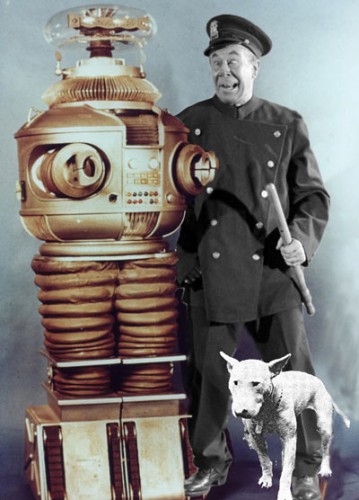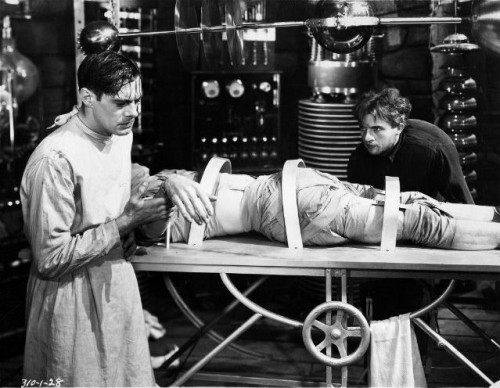Each Thursday, I’ll be stringing together some of the disconnected thoughts I’ve had about the subject of my dissertation in a feature I call “Thesis Thursday“. This week has two Thursdays, as last week I took a bye, so enjoy the first ((And hopefully last.)) ” Thesis Tuesday”:

Not pictured: the filthy scarecrow who waves his broomstick arms and does a parody of each unconscious thing you do.
It occurs to me that my last post in this series managed to assemble an ersatz Oz Squad, ((With the robot from Lost in Space as the substitute Tin Man, Patton’s dog William the Conqueror the Toto, the scarecrow from They Might Be Giants’ “Where Your Eyes Don’t Go” the Scarecrow, and… uh, Bert Lahr the Cowardly Lion.)) which leaves either me or Geoffrey of Monmouth in the Dorothy spot, and I’m not sure which of us it is. If I might be allowed an additional rhetorical device as a transparent attempt to avoid that troubling question, ((The way I burn through these metaphors each week, there soon might not be any left. Alert Greenpeace.†
†On second thought, don’t alert Greenpeace. The last thing I need is a bunch of gung ho do-gooders boarding the nuclear submarine of my brain.††
†† Ooops. There goes another metaphor, so casually discarded. There’s a crying Native American ††† standing outside my window now, and it’s totally freaking me out.
††† He’s sad because unlike we wasteful colonial bloggers, Native American bloggers used all the parts of the metaphor, not just the–OK, I’ll stop now before there’s a † shortage, too.)) Geoffrey and I are going to slip out the back while the Wizard is speechifying and skip over to a movie playing across the street.
What’s on the marquee? As if the title of this post hadn’t already tipped you off: the 1931 Boris Karloff Frankenstein. Here, Geoffrey and I are on surer footing. Clearly, he’ll be taking on the role of the titular doctor, and I his humble servant Igor Fritz. For like Geoffrey, Dr. Henry Frankenstein gets a bad rap, all things considered. Yes, digging up corpses and stitching them together is not exactly socially acceptable behavior, but our revulsion at the nature of the act keeps us from recognizing how impressive the the good doctor’s achievement really was. Whatever else you want to say about him–all that “meddling with the forces man was not meant to control” business ((Or, as a different medieval Geoffrey put it, messing around with God’s private parts (“Men sholde nat knowe of goddes pryvetee”).)) –Frankenstein was nevertheless awful good at his job. I mean, do you know of any another nineteenth-century doctors who could create life? ((If I’d been around then, I would’ve definitely tried to get on a health plan that covered his services.))
As I’ve argued at some length in the previous posts, Geoffrey’s monstrous reputation keeps us from fully appreciating what he managed to pull off, the monster he managed to create. But think of what we could learn, if we could swallow our disgust long enough to go poking around Frankenstein’s lab, or, say, examine the remains of the famous creation that has come to bear his name. So let us go then, you and I, and at last examine the patient etherized upon the table, Uther Pendragon. He is not, I’ll admit, the most famous result of the mad historian’s unholy experimentation, but as I hope to show, the key to understanding how Geoffrey made his Arthur lies in understanding his Uther.
I would imagine that most of my readers are probably unfamiliar with the details of Uther’s life set out in Geoffrey’s Historia. We have Thomas Malory to blame for that. His Book of Arthur And His Knights (AKA, Le Morte d’Arthur) is the source from which the modern understanding of Arthur derives in the English-speaking world, and Malory had the temerity to excise Uther almost entirely from his version of the Arthurian story, keeping only the details of Arthur’s supernatural siring, most of Uther’s life before he became Arthur’s father left, alas, on the cutting room floor. I hate to keep amping up the suspense in this post series, ((Because eventually it will reach the point that nothing I can say will meet the accumulated expectation.)) but it will be almost impossible to cover even the basic facts of Uther’s story in Geoffrey all at once. The creature before us on the table is large and the stitching holding his parts together intricate and extensive. So we must begin piecemeal, looking at each part separately before moving on to the whole.

In Geoffrey’s Historia, Uther’s story begins with the Roman withdrawal from Britain, which, depending on the source you consult, went down sometime around the end of the fourth and the beginning of the fifth century. Fortunately, we can be fairly sure which source Geoffrey consulted, for his timeline appears to be built upon that found in Nennius’s ninth-century Historia Brittonum, which is itself based upon material found in Gildas’s sixth-century De Excidio et Conquestu Britanniae(On the Ruin and Conquest of Britain). Historically speaking, this period marked the last gasp of British sovereignty over the island of Britain, and both Gildas and Nennius agree that once the Romans left, the British were never able to get their act together for very long, driven to desperation both by famine and by the depredations of the Picts and Scots to the north. In these sources and the others available to Geoffrey, the British cast about fitfully for help, even inviting the Romans back into Britain to fight off their enemies, but help never lasts for long and eventually dries up entirely. The History of the British is more or less at an end.
[Continued on Page 2 below]